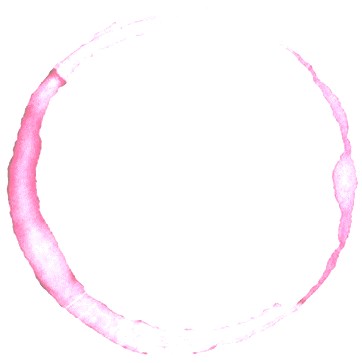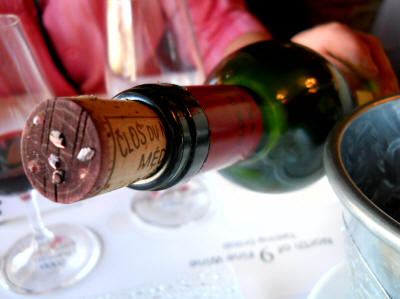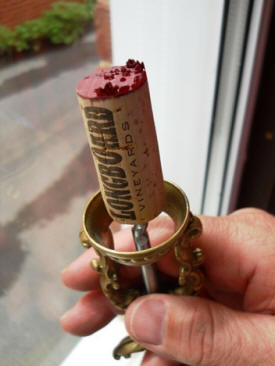
< Previous / Next >
 |
Article Index < Previous / Next > |

Corked Wine or a Flawed Perception?
Not long ago, at an upscale dining establishment on the
outskirts of Aurora, Ontario, my wife and I were sitting together at a table
in the corner enjoying a lovely bottle of Chianti with our bruschetta and
pasta entrées. Joia Ristorante is a great place to eat, and I think that
perhaps we both feel a few years younger than we really are as we sit
amongst the hustle and bustle of the waite staff watching people come and
go. But it’s fun to get dressed up, ditch the kids and hit the town for a
great meal paired with a good bottle of wine.
At the table adjacent to ours, a couple were engaged in a rather heated
discussion with the waiter. Apparently, there were ‘bits of hard stuff’
stuck to the bottom of the cork from the bottle he had opened for them only
moments before. From my vantage-point, I was unable to identify the label on
the bottle but judging by the body language and ensuing performance, it was
clearly a finer choice on the wine list, which incidentally, one might
mistake for an old leather-bound bible. Within the coveted document, patrons
are presented with a plethora of very fine (and expensive) choices. But
expensive wine also comes with an elevated expectation, which is perfectly
acceptable – if you know what to look for. Let’s put it this way: a 15 year
old bottle from France’s Côtes du Rhône will only vaguely resemble the
recently harvested Aussie Shiraz that you opened last summer to sip poolside
with the burgers in your backyard. The challenge however, is that most
patrons do not recognize how significantly a bottle of wine can change with
time. ‘It’s flawed’ demanded the couple, and without even tasting the
contents, ‘Take it away!’

One of the more fascinating aspects of the great transformation which occurs
inside a bottle of wine is the concept of sedimentation. Save for a minute
amount of oxygen transfer, the bottle is essentially a sealed environment
and while nothing has entered or left the bottle, the composition of the
contents has changed; in some cases rather significantly. Colour and tannin
precipitate out of the liquid solution in the form of a powder-like sediment
that collects in the bottle and this formation is both natural and
inevitable the longer the bottle sits. During the winemaking process
however, should the bottle not be subjected to cold stabilization (which I
will explain shortly) a crystal-like mineral deposit may form and settle at
the bottom or in some cases, adhere itself to the cork. Though formally
known as Tartrates, these crystals are also referred to as Wine Diamonds.
Normally, the crystals are dull or colourless while on other occasions they
remain bright and vibrant. What you are actually looking at is mineralized
tartaric acid (potassium bitartrate crystals). It's harmless and contrary to
popular belief, does not indicate a flawed bottle of wine. Wine diamonds
develop only under certain conditions and are an indication of well made
wine. Generally, the grapes used in the production of a wine which develops
tartrates were allow to full ripen on the vine and thus contain a higher
brix level (sugar conten t). Additionally, the fermentation process was not
accelerated nor artificially tampered with to expedite the bottling process
- hence, well made wine.
t). Additionally, the fermentation process was not
accelerated nor artificially tampered with to expedite the bottling process
- hence, well made wine.
In North America, we don't readily accept unfiltered wine as the normal;
simply put, people don't want bits of stuff floating about in their wine
glass. To prevent this, the wine is filtered several times and in some
cases, subjected to a process called 'Cold Stabilization' - it just sounds
bad doesn't it? It's actually very straightforward: To prevent the formation
of tartaric acid minerals in the bottle, winemakers rapidly cool the wine in
a large stainless steel tanks. The sudden cold temperature causes the
tartaric acid to precipitate out of the liquid and fall to the bottle of the
vessel. The clear wine is then pumped or siphoned off the top for bottling
or additional filtering, but here is the catch, for clarity does not come
without cost... Purists, enthusiasts, and those who claim to taste the
difference in terrior from one row of vines to the next will attest that
cold stabilization and excessive filtration also strips a wine of its unique
personality and the more you drink wine that has not been over-processed,
the sooner you will realize that they just might be correct.
The next time you pop a cork, remember that what goes on inside a sealed
bottle of wine is still one of life’s great mysteries. Don’t be too quick to
find fault with the contents if something is seemingly out of place. And if
you do discover a few diamonds in the rough, consider yourself very
fortunate.
| return to the Article Index |
Tyler Philp is a member of the Wine Writers' Circle of Canada Please direct inquires for writing services to: info@tylerphilp.com |
| Copyright © 2013 Tyler Philp
prior permission required for duplication of material |